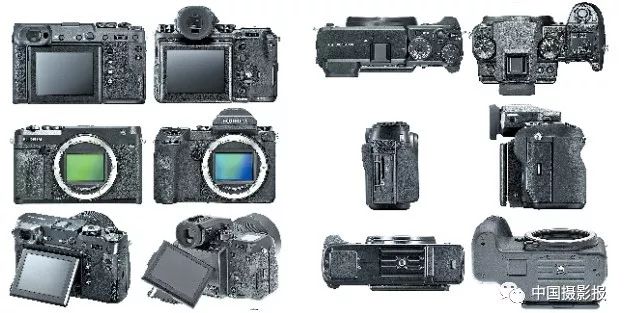
Comparison of the appearance of Fujifilm GFX 50R (left) and GFX 50S (right)
With its 51.4 million pixel medium format image sensor, the Fujifilm GFX 50S achieves image quality that is difficult for 35mm full-frame image sensors to match, but this also results in a larger body size and a higher price. However, compared to the well-known Phase One and Hasselblad, the Fujifilm GFX series, which adopts a mirrorless structure design, is indeed much lighter and significantly more affordable.
As a result, since its release in January 2017, the GFX 50S has performed well in the market and has received positive user feedback. The GFX 50R is the second product in the GFX mirrorless medium format camera system, which has undergone significant improvements based on user feedback from the GFX 50S. You could even consider it a newly designed Fujifilm medium format mirrorless camera product.
So what improvements has Fujifilm made on the GFX 50R? How should we choose between the GFX 50R and GFX 50S, which have a significant price difference?
Differences in Design and Appearance
The GFX 50S resembles a DSLR, featuring a detachable electronic viewfinder on top and a relatively large protrusion behind the rear display. The GFX 50R, on the other hand, resembles a rangefinder camera, with its electronic viewfinder designed in a rangefinder style located at the upper left corner of the camera instead of on top.
In contrast, the GFX 50S has more complex lines and requires more space for storage, while the GFX 50R is a regular rectangular block, requiring less storage space and making it more portable.
The GFX 50R’s back does not have a protrusion due to battery compartment space, significantly reducing the body thickness to 66.4mm, making it more compact.
When comparing the GFX 50S with an electronic viewfinder to the GFX 50R, the GFX 50S has a body width of approximately 147.5mm, a height of about 113.8mm, and a thickness of about 91.4mm; the GFX 50R has a body width of approximately 160.7mm, a height of about 96.5mm, and a thickness of about 66.4mm. Looking purely at the data, the differences between the two are not significant, but when the two cameras are placed side by side, the difference becomes quite apparent.
In terms of weight, the difference is also considerable. The GFX 50S with an electronic viewfinder weighs 920 grams, while the GFX 50R weighs 775 grams, making it 145 grams lighter.
Differences in Viewfinder System
The GFX 50R is equipped with a 0.5-inch OLED electronic viewfinder that provides 100% field of view and a magnification of 0.77x. Compared to the GFX 50S, which also offers 100% field of view but with a magnification of 0.85x, the GFX 50R does not have any advantages. Moreover, both cameras have electronic viewfinders with a resolution of 3.69 million pixels, with minimal parameter differences.
However, the main difference between these two electronic viewfinders lies in the design of the optical components rather than the technical specifications. The GFX 50R has a viewfinder angle of 38 degrees, which is more comfortable compared to the GFX 50S’s 40-degree angle.
It is important to note that the designs of these two electronic viewfinders are completely different; the GFX 50S allows for free angle adjustments, while the GFX 50R can only be observed and framed horizontally.
Similarly, the LCD touch screens on the back of the GFX 50R and GFX 50S have essentially the same technology. The GFX 50R features a 3.2-inch 4:3 screen with approximately 2.36 million pixels and 100% field of view. The parameters of the GFX 50S are also quite similar. However, unlike the GFX 50S, the GFX 50R’s LCD display can only tilt up and down, without lateral movement. This design is mainly due to the limited demand for side tilting displays, which would increase structural complexity and body thickness.
Additionally, the GFX 50R does not have the top shoulder display like the GFX 50S, instead placing all shoulder display functions on the rear LCD screen. This is also a compromise made to minimize body size, which does not significantly impact user control experience.
Differences in Reliability
The GFX 50R maintains Fujifilm’s high protection design philosophy for mirrorless cameras, with 64 areas inside the body featuring dust and drip-proof sealing design, effectively resisting general wind, rain, and dust intrusion from buttons, body seams, and lens mounts. The body shell is made of magnesium alloy, further enhancing durability and reliability. It can be said that the GFX 50R is a medium format mirrorless camera that can shoot in various harsh and complex weather conditions. The GFX 50S also has 58 areas with dust and drip-proof sealing design, making it equally capable of operating in harsh and complex weather conditions. In practical use, the difference between 64 and 58 sealed areas is not significant; the protective capabilities are similar, differing only in body structure.
Of course, the GFX 50R is indeed more compact and smaller than the GFX 50S, but this increase in portability comes at a cost. The GFX 50S has a well-designed front grip, while the GFX 50R does not.
Differences in Imaging System
In terms of imaging performance, the Fujifilm GFX 50R uses the same 51.4 million pixel image sensor as the GFX 50S. This sensor is not a “full-size” medium format sensor but rather measures 43.8mm x 32.9mm. Although it is slightly larger than a 35mm full-frame image sensor, it is still significantly smaller compared to sensors used in full-size medium format digital backs like the Phase One IQ4 150MP.
Therefore, based solely on the image quality of the GFX 50S, it is clear that the GFX 50R’s imaging quality is certainly better than that of 35mm full-frame cameras, but it will not differ significantly from the GFX 50S.
Additionally, the pixel pitch of this image sensor is approximately 5.31 microns, and it features a low-pass filter-less design with ultrasonic vibration automatic cleaning function. Compared to 35mm full-frame sensors, the GFX 50R’s sensor has about 0.79 times the focal length multiplier, meaning that the 35mm equivalent focal length of the GF 32-64mm F4 lens is approximately 25-51mm.
In terms of image processing, the GFX 50R, like the GFX 50S, uses the Fujifilm X-Processor Pro image processing engine. This engine is designed to provide high-quality color and tone reproduction and also supports Fujifilm film simulation modes: Provia, Velvia, Astia, Classic Chrome, Pro Neg, etc.
Moreover, the GFX 50R can record RAW images with a depth of up to 14 bits in uncompressed or lossless compressed settings and can generate 24-bit TIFF files through in-camera RAW conversion. The GFX 50R’s ISO range is from ISO100 to ISO12800, expandable up to ISO50-ISO1024000.
Differences in Autofocus and Performance
The GFX 50R uses the same autofocus system as the GFX 50S, including contrast detection autofocus and 425 autofocus points. The autofocus area covers most of the viewfinder frame, with focus selection modes including single point (6 sizes), area AF, and wide/tracking AF area modes.
This camera offers face and eye detection autofocus, including left and right eye priority, and features object tracking continuous autofocus.
In terms of continuous shooting speed, neither the GFX 50S nor the GFX 50R is a high-speed continuous shooting camera, with a maximum continuous shooting speed of 3 frames per second, allowing for a single burst of 8 uncompressed RAW format photos. If using lossless compressed RAW file format, this can be increased to a single burst of 13 shots.
The focal plane shutter system used in the GFX 50R and GFX 50S is the same, providing shutter speeds from 60 minutes to 1/4000 seconds. There is also an electronic shutter that can achieve shutter speeds as fast as 1/16000 seconds.
Regarding flash synchronization, both the GFX 50S and GFX 50R only have a flash sync speed of 1/125 seconds, which is slower than the Hasselblad X1D and most 35mm full-frame cameras.
In terms of shooting functions, the camera’s metering modes include multi-point, spot metering, average, and center-weighted, with spot metering mode supporting metering linked to the autofocus point.
Other Differences
Clearly, neither the GFX 50S nor the GFX 50R is a product focused on video capabilities, so their video functions have not changed with the product updates. Similarly, the GFX 50R can record full HD (1920×1080) video at a maximum of 29.97fps, with a bitrate of up to 36Mbps, and can continuously shoot for 30 minutes.
The addition of Bluetooth connectivity is one of the main differences between the GFX 50S and GFX 50R. The GFX 50R features Bluetooth 4.0 low energy technology, allowing for image geotagging, image transfer, image viewing, printing to Instax printers, automatic image transfer, and remote control functions.
There are also some differences in the interface settings of the GFX 50R and GFX 50S. The GFX 50R uses a 2.5mm microphone/remote control socket, while the GFX 50S uses separate 3.5mm microphone and headphone sockets, along with a 2.5mm remote control socket.
Additionally, the GFX 50R uses a USB Type-C (USB 3.1 Gen 1) interface, while the GFX 50S uses a Micro USB 3.0 (Micro-B) interface. The USB port of the GFX 50R is located at the bottom of the camera, next to the 15V DC IN port, and no longer supports Fujifilm’s RR-90 wired remote shutter.
In terms of storage media, the specifications of the GFX 50R and GFX 50S are quite similar, but for practical applications, it is recommended to use UHS-II SD/SDHC/SDXC memory cards.
Regarding batteries, the GFX 50R and GFX 50S use the same NP-T125 lithium-ion battery pack, which can take approximately 400 photos on a single charge, with power consumption being roughly equivalent to that of the GFX 50S.
Purchase Recommendations
If you prioritize image quality, there will not be a significant difference between the GFX 50R and GFX 50S. It is important to note that they use the same imaging system, and many shooting functions and technical parameters are quite similar.
The biggest difference between the GFX 50R and GFX 50S lies in their design and appearance. As we have seen, the GFX 50R features a rangefinder-style design, making the body more compact and its regular shape easier to store and carry. However, this difference in appeal to users varies; those who prefer DSLR designs will choose the GFX 50S.
From this perspective, the GFX 50R can be seen as a more cost-effective option that reduces overall operational difficulty in medium format mirrorless cameras. It serves as a more portable and user-friendly camera in addition to the GFX 50S, rather than a replacement product.
Therefore, for those who have not yet purchased the GFX 50S, the GFX 50R is a suitable choice for first-time buyers of medium format mirrorless cameras, and it can largely replace the GFX 50S in landscape photography, portrait photography, and more. However, for photographers who already own the GFX 50S, there is little need to upgrade to the GFX 50R, as the essential differences between the two cameras are too small to provide a “qualitative” improvement for users.
Source: China Photography News


Long press the QR code to follow and learn more exciting content